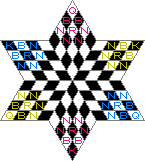Fiancé Chess
This variant is inspired by Doug Chatham's Bachelor Chess, which has no array Queen but allows victory by bringing the King and a promotee Queen together. This variant has the Queen already in the array, but separated from the King in one of two opposite-corner camps per player and still with the potential to win by bringing them together. I considered it for two players but concern about asymmetries, Bishop bindings, and winning by marriage being too easy drove me to a 3-player variant on the same 96-cell board as Chess for 3, 3 Handed Chess, 3 Player Chess, and Yalta. These have 12 ranks and 12 files each, but each rank intersects only two thirds of the files and vice versa. This variant differs in dividing each camp between two opposite rather than adjoining 4x4 sixths.That arrangement produced corner camps, and I decided that Pawn moves were too hard to define and so had extra minor symmetric pieces in place of Pawns. Interestingly FIDE armies can still be used, in the ratio of three sets, at least one distinguishable from the rest, for two simultaneous games.
Other variants of mine using the 6-cell centre are the smaller Triana and the larger Triple Crown.
Note that this is a different use of the word fiancé from that in Four Double-Acts Chess, where both Fiancé and Fiancée are names of pieces derived from the Friend.
Setup

Pieces
As in FIDE Chess, but in different proportions without Pawns. Knights can be represented by physical Pawns, Bishops of one binding by physical Knights and of the other by physical Bishops, and the rest by their normal representations. Individual pieces can be expressed as [red/yellow/blue] [King/Queen][/'s [Rook/[[left/right] [Bishop/[[Rook/Bishop]'s Knight]]]]]. I hope that I have included enough brackets to make it unambiguous!Rules
Red moves first, then Yellow, then Blue.The middle of the board follows the same rules as most variants on this board. A Bishop move can turn left or right at the centre, but not go straight across. Knight moves must be expressible in terms of a (not necessarily empty) Mao or Moa pass-through square, the diagonal stage following the above Bishop rule.
There is no initial double move, En Passant, promotion, or Castling.
A player is Checkmated when their King is threatened by the player about to move. That player's pieces are removed. Whichever of the last two remaining player Checkmates the other wins. A player who still has their Queen can also win by bringing their King and Queen to orthogonally or diagonally adjacent cells without being in Check, as in Bachelor Chess. This 'user submitted' page is a collaboration between the posting user and the Chess Variant Pages. Registered contributors to the Chess Variant Pages have the ability to post their own works, subject to review and editing by the Chess Variant Pages Editorial Staff.
This 'user submitted' page is a collaboration between the posting user and the Chess Variant Pages. Registered contributors to the Chess Variant Pages have the ability to post their own works, subject to review and editing by the Chess Variant Pages Editorial Staff.
By Charles Gilman.
Web page created: 2006-09-29. Web page last updated: 2007-09-23